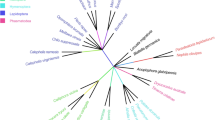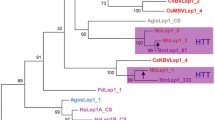Abstract
Helentrons represent a novel subtype of Helitrons. However, the evolutionary history of Helentrons in organisms is not clearly understood. In this study, we performed structure and autonomous partner analyses, which revealed that bm_455, a TE obtained from the Bombyx mori TE database, BmTEdb, was a member of Helentrons but not a long-terminal repeat (LTR) retrotransposon. Further analyses showed that bm_455 was also present in a wide range of insects including lepidopterans, coleopterans and hymenopterans using a homology-based search strategy. Several lines of evidence (high sequence identity, discontinuous distribution and lack of intense purifying selection) suggested that these elements could have been transferred into these species in part by horizontal transfers (HTs). Because Helentrons can capture host gene fragments, HTs of Helentrons might have a huge impact on their host genome evolution.




Similar content being viewed by others
References
Altschul SF, Gish W, Miller W, Myers EW, Lipman DJ (1990) Basic local alignment search tool. J Mol Biol 215:403–410
Barbaglia AM, Klusman KM, Higgins J, Shaw JR, Hannah LC, Lal SK (2012) Gene capture by Helitron transposons reshuffles the transcriptome of maize. Genetics 190:965–975
Cultrone A, Dominguez YR, Drevet C, Scazzocchio C, Fernandez-Martin R (2007) The tightly regulated promoter of the xanA gene of Aspergillus nidulans is included in a Helitron. Mol Microbiol 63:1577–1587
Du C, Fefelova N, Caronna J, He L, Dooner HK (2009) The polychromatic Helitron landscape of the maize genome. Proc Natl Acad Sci USA 106:19916–19921
Edgar RC (2004) MUSCLE: multiple sequence alignment with high accuracy and high throughput. Nucleic Acids Res 32:1792–1797
Ellison CE, Bachtrog D (2013) Dosage compensation via transposable element mediated rewiring of a regulatory network. Science 342:846–850
Gilbert C, Hernandez SS, Flores-Benabib J, Smith EN, Feschotte C (2012) Rampant horizontal transfer of SPIN transposons in squamate reptiles. Mol Biol Evol 29:503–515
Gorbunova V, Levy AA (1997) Non-homologous DNA end joining in plant cells is associated with deletions and filler DNA insertions. Nucleic Acids Res 25:4650–4657
Grabundzija I, Messing SA, Thomas J, Cosby RL, Bilic I, Miskey C, Gogol-Döring A, Kapitonov V, Diem T, Dalda A, Jurka J, Pritham EJ, Dyda F, Izsvák Z, Ivics Z (2016) A Helitron transposon reconstructed from bats reveals a novel mechanism of genome shuffling in eukaryotes. Nat Commun 7:10716
Guo X, Gao J, Li F, Wang J (2014) Evidence of horizontal transfer of non-autonomous Lep1 Helitrons facilitated by host-parasite interactions. Sci Rep 4:5119
Hall TA (1999) BioEdit: a user-friendly biological sequence alignment editor and analysis program for Windows 95/98/NT. Nucleic Acids Symp Ser 41:95–98
Han MJ, Shen YH, Xu MS, Liang HY, Zhang HH, Zhang Z (2013) Identification and evolution of the silkworm helitrons and their contribution to transcripts. DNA Res 20:471–484
Hartl DL, Lozovskaya ER, Nurminsky DI, Lohe AR (1997) What restricts the activity of mariner-like transposable elements. Trends Genet 13:197–201
Hedges SB, Dudley J, Kumar S (2006) TimeTree: a public knowledgebase of divergence times among organisms. Bioinformatics 22:2971–2972
Kalendar R, Lee D, Schulman AH (2014) FastPCR software for PCR, in silico PCR, and oligonucleotide assembly and analysis. Methods Mol Biol 1116:271–302
Kapitonov VV, Jurka J (2001) Rolling-circle transposons in eukaryotes. Proc Natl Acad Sci USA 98:8714–8719
Kidwell MG (1992) Horizontal transfer of P-elements and other short inverted repeat transposons. Genetica 86:275–286
Poulter RTM, Goodwin TJD, Butler MI (2003) Vertebrate helentrons and other novel Helitrons. Gene 313:201–212
Schaack S, Gilbert C, Feschotte C (2010) Promiscuous DNA: horizontal transfer of transposable elements and why it matters for eukaryotic evolution. Trends Ecol Evol 25:537–546
Tamura K, Dudley J, Nei M, Kumar S (2007) MEGA4:molecular evolutionary genetics analysis (MEGA) software version 4.0. Mol Biol Evol 24:1596–1599
Thomas J, Pritham EJ (2015) Helitrons, the eukaryotic rolling-circle transposable elements. Microbiol Spectr 3(4)
Thomas J, Schaack S, Pritham EJ (2010) Pervasive horizontal transfer of rolling-circle transposons among animals. Genome Biol Evol 2:656–664
Thomas J, Vadnagara K, Pritham EJ (2014) DINE-1, the highest copy number repeats in Drosophila melanogaster are non-autonomous endonuclease-encoding rolling-circle transposable elements (Helentrons). Mob DNA 5:18
Xia X, Xie Z (2001) DAMBE: software package for data analysis in molecular biology and evolution. J Hered 92:371–373
Xu HE, Zhang HH, Xia T, Han MJ, Shen YH, Zhang Z (2013) BmTEdb: a collective database of transposable elements in the silkworm genome. Database (Oxford) bat055
Yang L, Bennetzen JL (2009) Distribution, diversity, evolution, and survival of Helitrons in the maize genome. Proc Natl Acad Sci USA 106:19922–19927
Zhang HH, Xu HE, Shen YH, Han MJ, Zhang Z (2013) The origin and evolution of six miniature inverted-repeat transposable elements in Bombyx mori and Rhodnius prolixus. Genome Biol Evol 5:2020–2031
Zhang HH, Feschotte C, Han MJ, Zhang Z (2014) Recurrent horizontal transfers of Chapaev transposons in diverse invertebrate and vertebrate animals. Genome Biol Evol 6:1375–1386
Acknowledgements
This study was funded by the National Natural Science Foundation of China (31560308 and 31401106), the Natural Science Foundation of Jiangxi Province (20161BAB214151) and the Hi-Tech Research and Development (863) Program of China (2013AA102507).
Author information
Authors and Affiliations
Corresponding author
Ethics declarations
This article does not contain any studies with human participants or animals performed by any of the authors.
Conflict of interest
HHZ declares that he has no conflict of interest. GYL declares that he has no conflict of interest. XMX declares that she has no conflict of interest. MJH declares that he has no conflict of interest. FYD declares that he has no conflict of interest.
Additional information
Communicated by S. Hohmann.
H.-H. Zhang, G.-Y. Li and X.-M. Xiong contributed equally to this work.
Electronic supplementary material
Below is the link to the electronic supplementary material.
438_2016_1270_MOESM5_ESM.pdf
Figure S1 Multiple alignments of non-autonomous Helentrons identified in this study. Their subTIRs and stem-loop were shown using black and red boxes, respectively (PDF 2602 kb)
438_2016_1270_MOESM6_ESM.pdf
Figure S2 Multiple alignments of the incomplete endonuclease encoded by Helentron_NA_CV with those of other reported Helentrons. A 175 aa protein was identified in the Helentron_NA_CV using ORF Finder (http://www.ncbi.nlm.nih.gov/gorf/orfig.cgi). This protein contained partial endonuclease sequences, which have 3/6 (V-VII) conserved motifs of complete endonuclease. Helentrons of other species was obtained from previous study (Thomas et al. 2014). Species abbreviations are as follows: CV, Cotesia vestalis; DR, Daniorerio; XM, Xiphophorus maculatus; SK, Saccoglossus kowalevskii; MC, Mucor circinelloides (PDF 206 kb)
Rights and permissions
About this article
Cite this article
Zhang, HH., Li, GY., Xiong, XM. et al. Horizontal transfer of a novel Helentron in insects. Mol Genet Genomics 292, 243–250 (2017). https://doi.org/10.1007/s00438-016-1270-4
Received:
Accepted:
Published:
Issue Date:
DOI: https://doi.org/10.1007/s00438-016-1270-4




